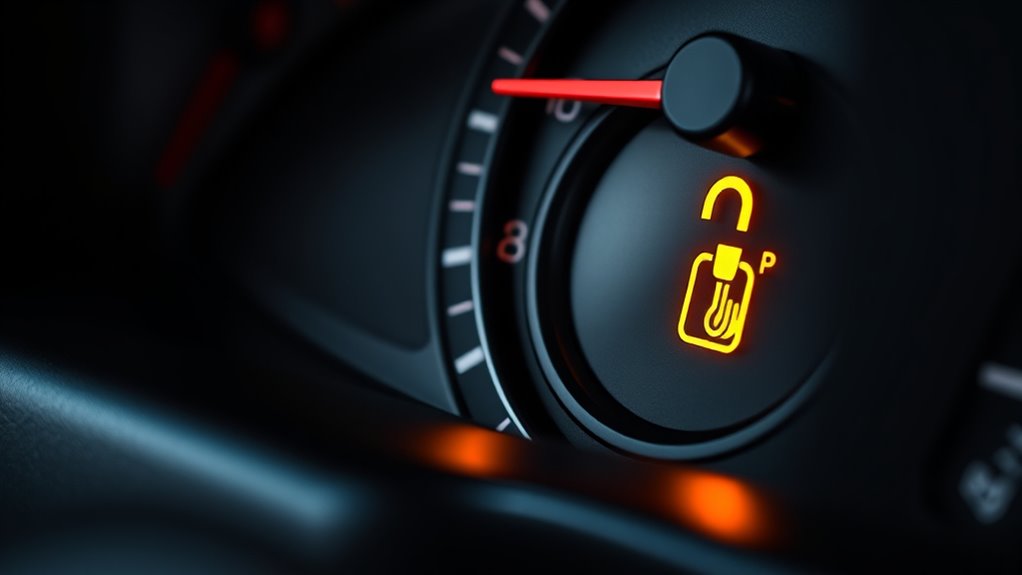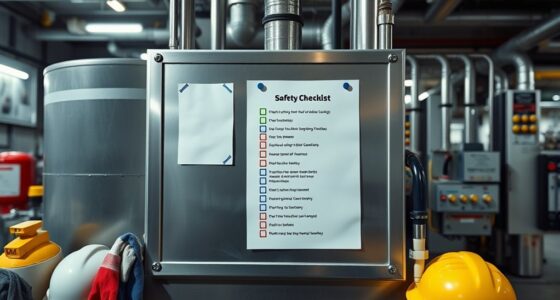Understanding oil pressure faults is key to keeping your engine running smoothly. Many believe warning lights always mean major damage, but simple issues like low oil levels or faulty sensors can trigger them. False alarms happen, and proper diagnosis is crucial. Regular checks of oil quality, level, and leaks help prevent problems. To fully protect your engine and avoid costly repairs, you’ll discover essential tips and truths that make maintaining oil pressure clearer and more manageable.
Key Takeaways
- Proper oil pressure indicates engine health, but warning lights often trigger false alarms from faulty sensors.
- Common causes of oil pressure faults include oil pump failure, incorrect viscosity, leaks, and engine wear.
- Regular maintenance, correct oil level, and timely filter changes prevent pressure issues and prolong engine life.
- Immediate action involves stopping the engine, checking oil level, inspecting for leaks, and consulting professionals if needed.
- Faulty sensors can cause false readings; always verify with mechanical gauges and seek expert diagnosis for persistent problems.
Understanding Oil Pressure: What It Is and Why It Matters
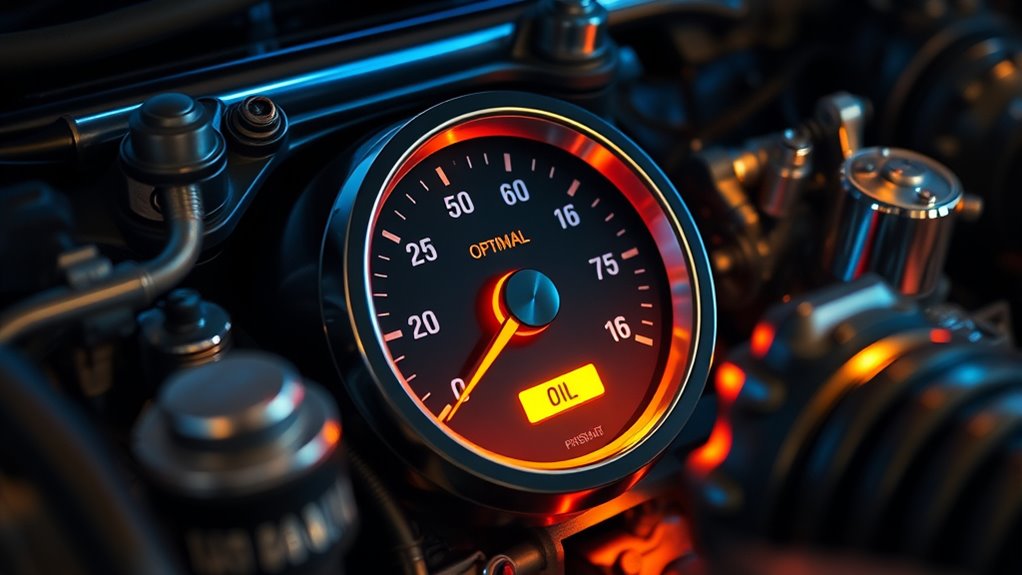
Understanding oil pressure is vital because it indicates how well your engine’s lubrication system is functioning. When your oil pressure is within the correct range, it guarantees that oil reaches all engine parts, reducing wear and preventing damage. Oil viscosity plays a key role here; thicker oil may increase pressure, while thinner oil can decrease it. A pressure sensor continuously monitors this pressure, sending signals to your vehicle’s dashboard. If the sensor detects abnormal readings, it can trigger warning lights, alerting you to potential issues. Knowing what proper oil pressure looks like helps you recognize when something’s off, so you can address problems early. Maintaining correct oil viscosity and ensuring the pressure sensor functions properly are vital for engine health and longevity. Using the right oil type can also help maintain optimal pressure levels and ensure smooth engine operation.
Common Causes of Oil Pressure Faults

When oil pressure drops or spikes unexpectedly, it often signals a problem within the lubrication system. One common cause is a faulty oil pump, which can fail to circulate oil properly, leading to low pressure. Another factor is oil viscosity; using oil that’s too thin or thick for your engine can disrupt proper flow and pressure levels. Worn or clogged oil filters can also restrict oil flow, causing pressure issues. Additionally, leaks in seals or gaskets can reduce oil volume, resulting in pressure drops. Finally, engine wear—such as worn bearings—can increase clearances, making it harder for oil to maintain correct pressure. Proper maintenance and understanding oil pressure faults can help prevent more serious damage and guarantee your engine stays properly lubricated.
Recognizing Symptoms of Oil Pressure Problems
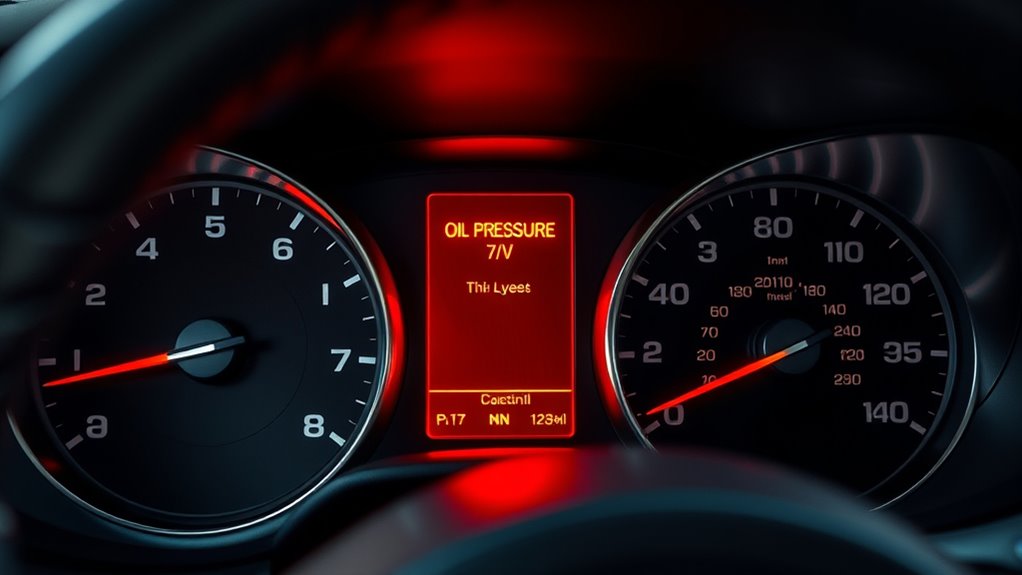
If your vehicle’s oil pressure drops unexpectedly or fluctuates erratically, you’ll likely notice certain warning signs. You might see the oil pressure warning light illuminate, or experience a fluctuating gauge reading. Unusual engine noises, like knocking or ticking, can also signal trouble. Additionally, your vehicle may stall or run poorly if oil isn’t circulating properly. Sometimes, faulty oil pressure sensors give false readings, but persistent warning lights shouldn’t be ignored. Pay attention to these symptoms to prevent engine damage. Here’s a quick overview:
| Symptom | Possible Cause |
|---|---|
| Warning light activates | Faulty oil pressure sensor or oil level |
| Unusual engine noises | Low oil pressure or oil pump issues |
| Erratic gauge readings | Sensor malfunction or electrical fault |
| Engine stalling | Severe oil pressure loss |
Recognizing these signs helps you act quickly. Additionally, understanding the significance of proper oil circulation can help you better interpret these symptoms and take appropriate action.
Debunking Myths About Oil Pressure Faults

Many people believe that a warning light always means serious engine damage, but that’s not true. Some myths suggest low oil pressure is always caused by a failing pump, when it can be something simpler. Let’s clarify the facts and understand what’s really behind oil pressure faults. For example, effectiveness of eye patches shows that not all treatments produce permanent results, similar to how a warning light may not always indicate a critical issue.
Common Misconceptions Clarified
Are oil pressure faults really as serious as they seem? Not always. Many misconceptions stem from misunderstandings about engine oil viscosity or faulty oil pressure sensors. For example, a change in engine oil viscosity can temporarily lower oil pressure readings without indicating a real problem. Similarly, faulty oil pressure sensors might trigger warning lights even when your engine’s oil pressure is fine. It’s easy to assume that a warning light means immediate engine damage, but sometimes it’s a false alarm. Knowing that sensor malfunctions or oil viscosity issues can influence readings helps you avoid unnecessary repairs. Regularly monitoring oil pressure levels and verifying readings with a mechanical gauge can help distinguish between real issues and false alarms. Misinterpreting these factors can lead to unnecessary repairs or overlooked problems, so understanding the facts is essential.
Reality Behind Oil Faults
Despite common fears, not all oil pressure faults signal imminent engine failure. Sometimes, a faulty oil filter or incorrect oil viscosity can cause oil pressure warnings without serious damage. For example, a clogged oil filter may restrict flow, triggering a fault light but not harming the engine if addressed promptly. Similarly, using oil with the wrong viscosity can lead to fluctuations in pressure readings, creating false alarms. Many people assume any oil pressure fault means catastrophic failure, but in reality, these issues often have simple solutions. Regular maintenance, including oil changes with proper viscosity and filter replacements, can prevent most false faults. Understanding that not every oil pressure warning indicates disaster helps you stay calm and act wisely, saving time and money. Additionally, knowing the signs of proper oil flow can help you better assess when a fault is truly critical.
The Role of Oil Quality and Oil Level in Maintaining Pressure
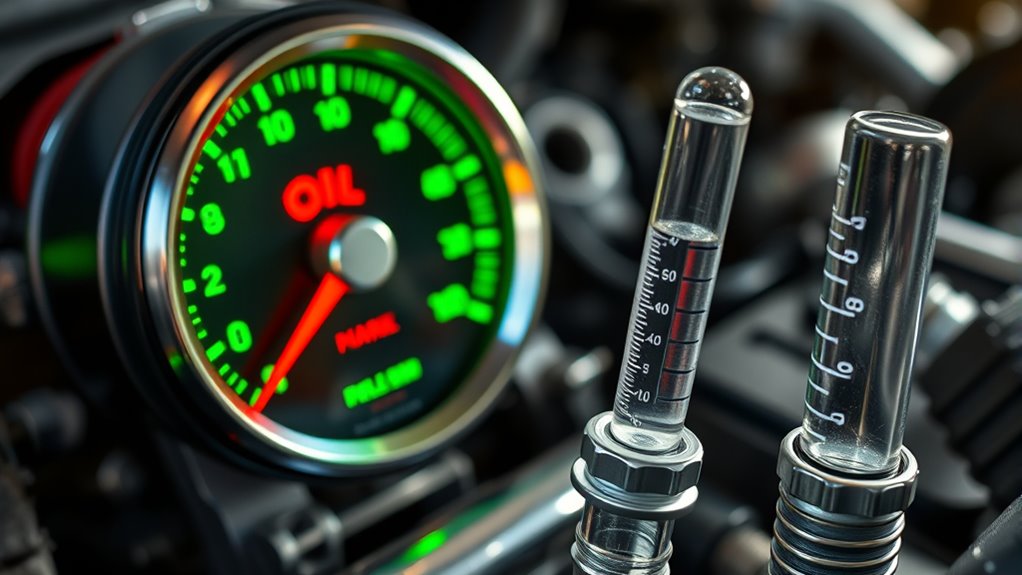
Maintaining proper oil quality and level is essential for guaranteeing consistent oil pressure in your engine. When your oil is clean and well-maintained, it lubricates engine parts effectively, reducing friction and preventing pressure drops. Using the right oil additives can enhance oil performance, helping to minimize sludge buildup and maintain engine cleanliness. If the oil level is too low, the pump struggles to circulate enough oil, causing pressure fluctuations or drops. Conversely, overfilling can cause aeration or foaming, also impairing pressure. Regularly checking and topping off your oil ensures ideal flow and pressure. High-quality oil with suitable additives keeps your engine clean and functioning smoothly, directly supporting stable oil pressure and preventing faults caused by poor lubrication. Additionally, understanding family photoshoot fails can remind you that even in complex systems, small oversights can lead to unexpected issues.
Diagnosing Oil Pressure Issues: Tools and Techniques
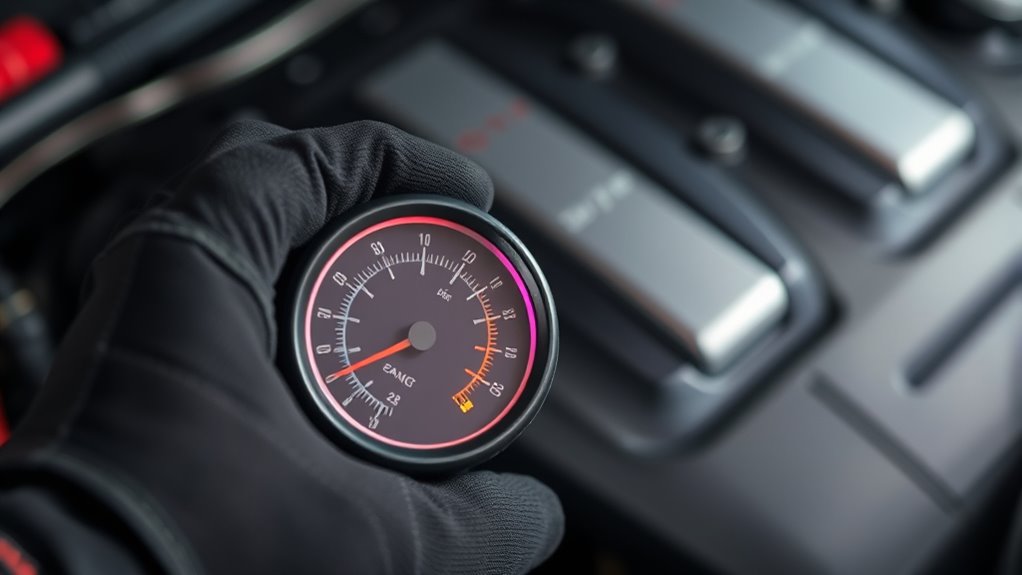
When oil pressure readings drop or fluctuate unexpectedly, it’s important to accurately diagnose the problem before attempting repairs. Start by using diagnostic tools like a mechanical oil pressure gauge to verify the readings, verifying your vehicle’s sensor isn’t giving false data. Check the sensor calibration, as an improperly calibrated sensor can produce misleading results. Use a multimeter or scan tool to test the sensor’s electrical connections and signal output. If readings remain inconsistent, consider replacing the sensor. Additionally, inspecting the wiring and connectors helps rule out simple faults. Proper diagnosis ensures you identify whether the issue stems from the sensor, wiring, or actual oil pressure problems, preventing unnecessary repairs and ensuring accurate troubleshooting. Regularly monitoring oil system components can help maintain oil pressure stability and prevent misdiagnosis.
Immediate Steps to Take When You Receive an Oil Pressure Warning
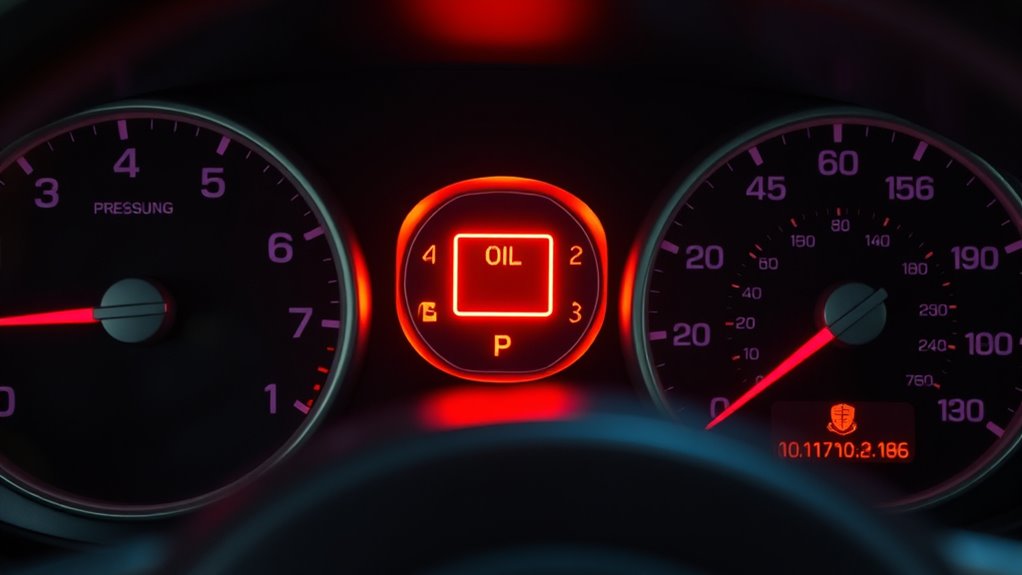
When you see an oil pressure warning, stop driving right away to prevent engine damage. Check your oil level and look for any leaks that might be causing the issue. Taking these immediate steps can help you assess the problem before it worsens. Additionally, inspecting oil filters for clogging or dirt buildup can ensure your engine’s lubrication system functions properly.
Stop Driving Immediately
If you see an oil pressure warning light or message, you must stop driving immediately. Continuing to drive can cause severe engine damage, especially if the engine oil viscosity isn’t appropriate or the oil filter quality is compromised. Low oil viscosity or a clogged oil filter can lead to insufficient lubrication, risking engine failure. Do not ignore the warning or wait for the engine to sound loud or rough. Instead, pull over safely, turn off the engine, and assess the situation. Driving with an oil pressure fault can quickly worsen if the oil isn’t flowing properly, so it’s vital to stop and investigate before further damage occurs. Acting promptly helps protect your engine’s health and your safety. Understanding AI detectors can also assist in diagnosing digital issues that may affect modern vehicle systems.
Check Oil Level
Wondering what to do immediately after seeing an oil pressure warning? First, pull over safely and turn off your engine. Then, check the oil level using the dipstick. Remove the dipstick, wipe it clean, reinsert it fully, and pull it out again to read the oil level. If the oil level is low, you need to add oil to bring it up to the recommended mark. Running your engine with insufficient oil can cause serious damage and false oil pressure readings. Always use the correct oil type specified in your vehicle’s manual. After checking and topping off, restart your engine and see if the warning persists. If it does, avoid driving further and seek professional help. Properly checking oil level is a simple but vital step in addressing an oil pressure warning.
Inspect for Leaks
Noticing an oil pressure warning often prompts you to look for obvious issues like leaks. Start by inspecting around the engine for any signs of oil leaks, such as wet spots, puddles, or oil stains. Leak detection is essential, so check hoses, seals, and gaskets for cracks or deterioration. Focus on the seal inspection points, especially around the oil filter, drain plug, and valve cover gasket. A small leak can cause a significant drop in oil pressure over time. If you spot fresh oil or accumulated grime near a seal, it’s a strong indicator of a leak. Addressing leaks promptly helps prevent further damage and guarantees your oil pressure stays within the safe range.
Long-Term Maintenance to Prevent Oil Pressure Faults
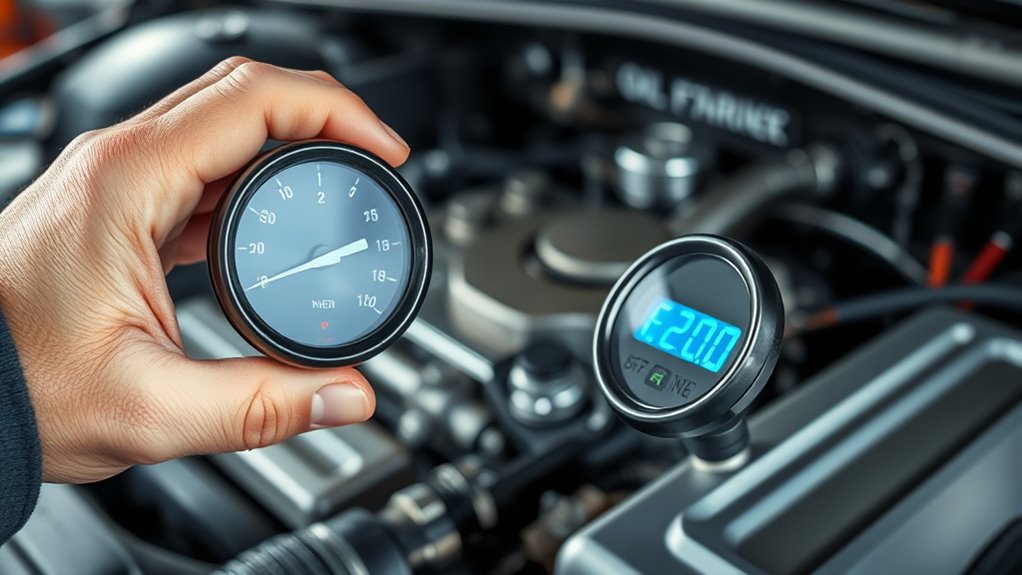
Regular long-term maintenance is essential for preventing oil pressure faults, as it guarantees your engine’s lubrication system remains in perfect condition. Start by regularly replacing your oil filter to ensure contaminants don’t impede oil flow, which can cause pressure drops. Use the correct oil viscosity recommended by your vehicle manufacturer, as incorrect viscosity can affect pressure levels and engine performance. Keep track of oil change intervals, and don’t delay replacements, especially if you notice oil thinning or thickening. Maintaining clean, properly rated oil and a fresh filter helps sustain ideal pressure and prevents strain on the pump and other components. Consistent maintenance minimizes the risk of pressure faults, extending your engine’s lifespan and enhancing overall reliability.
When to Seek Professional Help and Possible Repairs
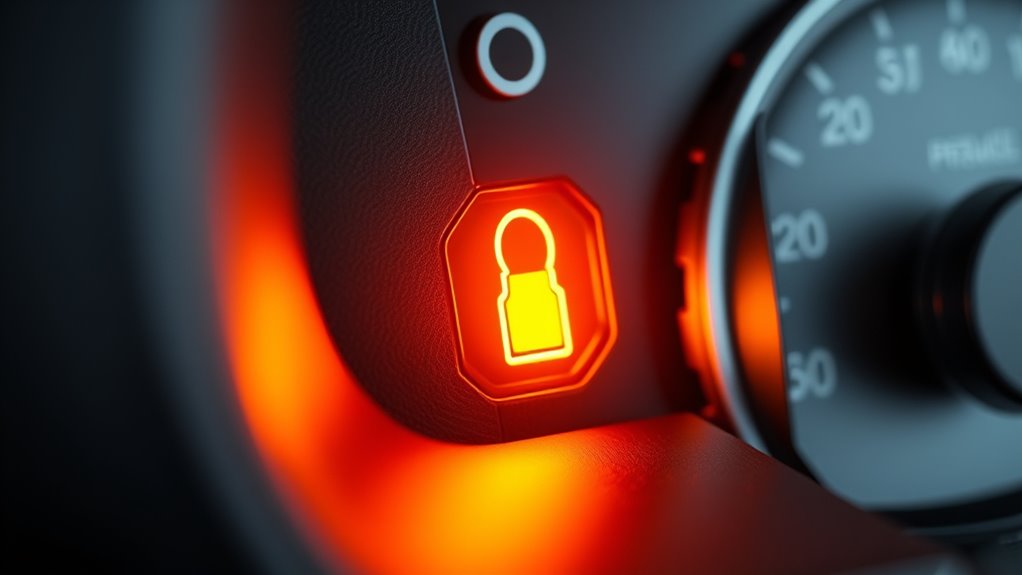
If you experience persistent oil pressure warnings or notice a sudden drop in oil pressure despite recent maintenance, it’s time to seek professional help. A qualified mechanic can perform professional diagnostics to identify the root cause quickly and accurately. Ignoring these signs can lead to serious engine damage, so don’t delay. Once diagnosed, the mechanic will discuss repair options, which may include replacing the oil pump, fixing leaks, or addressing faulty sensors. Trusting professionals ensures you get a proper fix rather than risking improper repairs that could worsen the problem. If symptoms persist or worsen, seek help promptly to protect your engine’s health and avoid costly repairs down the line. Always prioritize timely professional intervention when oil pressure issues arise.
Frequently Asked Questions
How Does Ambient Temperature Affect Oil Pressure Readings?
Ambient temperature substantially impacts your oil pressure readings because it influences oil viscosity. When it’s cold, oil thickens, making it harder for your engine to circulate, which can cause higher pressure readings. Conversely, warm temperatures thin the oil, resulting in lower pressure readings. You should consider ambient temperature changes when monitoring oil pressure, as they directly affect oil viscosity and can lead to misinterpretations of your engine’s health.
Can Using Synthetic Oil Prevent Oil Pressure Faults?
Using synthetic oil can act like a shield, helping prevent oil pressure faults. Its benefits include better oil viscosity, which guarantees consistent flow even in extreme temperatures. Synthetic oils resist breakdown and maintain ideal pressure longer than conventional oils, reducing the risk of pressure drops. By choosing synthetic, you’re giving your engine a smoother, more reliable ride through varying conditions, keeping oil pressure steady and your engine healthier.
Are There Vehicle-Specific Differences in Oil Pressure Fault Causes?
Yes, there are vehicle-specific differences in oil pressure fault causes. You need to perform vehicle-specific diagnostics because each model has unique oil systems and sensor placements that can affect fault detection. Understanding your vehicle’s particular oil system helps you accurately identify issues like pressure loss or sensor errors. Always refer to your vehicle’s repair manual or consult a professional to verify you’re addressing the correct causes based on your model’s specifications.
How Often Should Oil Pressure Sensors Be Tested or Replaced?
Think of your oil pressure sensor as a vigilant guardian watching your engine’s health. You should test its calibration every 30,000 miles or if you notice warning lights. Replace it roughly every 60,000 to 100,000 miles, or if it shows signs of malfunction. Regular testing guarantees accurate readings, helping you catch issues early. Proper replacement intervals keep your engine running smoothly and prevent costly damage.
Does Engine Age Influence the Likelihood of Oil Pressure Issues?
Yes, engine age increases the likelihood of oil pressure issues. As your engine ages, wear on components can cause oil flow disruptions, leading to pressure drops. Additionally, older engines often experience oil degradation due to prolonged use and heat, which further impairs lubrication and pressure stability. Regular maintenance and timely oil changes help mitigate these problems, but aging engines naturally face higher risks of oil pressure faults.
Conclusion
Remember, staying attentive to your oil pressure can prevent bigger engine issues down the road. Sometimes, a simple check or change might be all it takes—like catching a small leak before it becomes a costly repair. By understanding the basics, you’re more likely to notice the signs early. So, keep an eye on those warning lights, and who knows? That tiny oil pressure fault today might just save you from an unexpected breakdown tomorrow.
